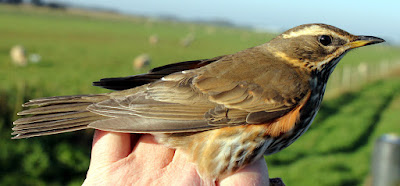After yesterday’s slightly underwhelming and fairly unproductive ringing session Andy and I decided we would have another go today. We met up at 0700 for the last time before the clocks revert to winter time settings, and for ringers, a return to earlier alarm bells for a week or two.
With clear skies and a promise of sunshine the weather this morning was decidedly better in terms of comfort for us ringers if not necessarily more suited to visible migration. We were correct. After a very early thrush rush the little migration there was came to a complete halt.
We caught 22 birds, thrushes named first to illustrate how the morning changed from a promising thrush rush to a titfest - 6 Redwing, 1 Song Thrush, 1 Blackbird, 1 Robin, 1 Goldfinch, 6 Coal Tit, 4 Blue Tit, 1 Wren, 1 Dunnock.
The post-dawn arrival of thrushes comprised of about 45 Redwings, 15 Fieldfare, 4 Mistle Thrush, 4 Blackbirds and the single Song Thrush above. Otherwise, and in the clear skies, 100+ Woodpigeon flew south west and 15/20 Chaffinch flew directly over without stopping off. A couple of Sparrowhawks, male and female, targeting thrushes enlivened proceedings but we caught none today.
Once again we failed to catch any Lesser Redpolls or Chaffinches, the single Goldfinch a recapture from recent days and again a complete absence of Siskins. We discussed whether Storm Ophelia and Hurricane Brian which hit the North West in quick succession had caused finches to head south and west somewhat earlier than normal. We then then countered that argument with the fact that during the storms the overall day and night temperatures remained balmy. Time will tell whether the fall in finch captures remains low or recovers to our usual levels when colder weather arrives.
Dunnock
Redwing
Song Thrush
Like many ringers we no longer catch Song Thrushes in good numbers since the species’ decline during the last 30/40 years.
Song Thrush - Turdus philomelos - British Trust for Ornithology
For many people the shy but once familiar Song Thrush is regarded as a garden bird only, and not one associated with migration. In actual fact the partially migratory Song Thrush breeds in most of Europe and across the Ukraine and Russia almost to Lake Baikal, cold regions which must be abandoned in winter. The species extends to 75°N in Norway and about 60°N in Siberia, and Song Thrushes from those regions winter around the Mediterranean, North Africa and the Middle East.
Some British Song Thrushes leave their breeding areas for Ireland, France or Iberia for the winter, although many undertake little seasonal movement unless prompted by severe weather.
The migration of birds from Europe can sometimes be evident across Britain in autumn, and is known to involve birds from as far east as Finland. However it is rarely possible to distinguish this from movements of local birds. Occasional continental individuals are reported in the UK in winter but it is clear that a high proportion of them continue further south, to at least France or Iberia. Vagrant Song Thrushes have been recorded far from their normal ranges, in places such as Greenland, West Africa and various Atlantic islands.
Meanwhile, the Lesser Redpolls we caught here this year continue on their journeys south as shown below by the unremarkable but instructive information.
Lesser Redpoll
A juvenile Lesser Redpoll S800301 ringed here at Oakenclough on 25th August 2017. Biometrics: Wing: 72.0 mm. Weight: 9.6 g. Time: 08:00:00hrs, was recaptured 181 degrees due south on 26th October 2017 at Billinge Hill, near Billinge, Merseyside. Biometrics: Wing: 71.0 mm. Weight: 10.5 g. Time: 09:00:00hrs. Duration: 62 days Distance: 47 km Direction: 181deg (S)
Lesser Redpoll - Oakenclough to Billinge















































































